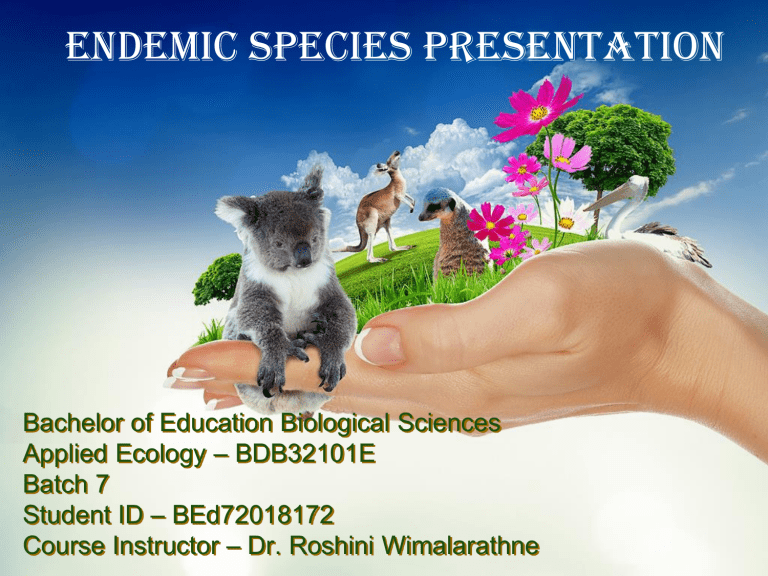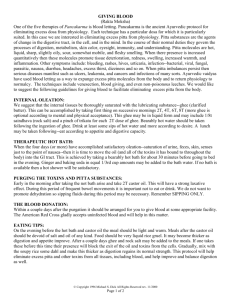
Endemic Species Presentation
Bachelor of Education Biological Sciences
Applied Ecology – BDB32101E
Batch 7
Student ID – BEd72018172
Course Instructor – Dr. Roshini Wimalarathne
CONTENT
2
Who are Endemic Species??
Endemic species are plants and animals
that exist only in one geographical region
which can be endemic to large or small
areas of the world; to a particular continent,
to a part of a continent or to a single island.
An endemic species are important because they are in the
habitats restricted to a particular area due to climate change,
urban development or other occurrences. Therefore endemic
species are often endangered and it is important to save the
species.
Factors affecting Endemic Species
1. Habitat loss and fragmentation
due to draining and filling of
inland wetlands
2. Pollution
Species become endemic in 2 ways
1. Autochthonous or native
2. Allochthonous
4
Ceylon Whistling Thrush
Myophonus blighi
Taxonomy and scientific classification of
Myophonus blighi
Kingdom
Animalia
Phylum
Chordata
Class
Aves
Order
Passeriformes
Family
Muscicapidae
Genus
Myophonus
Species
Myophonus blighi
(Holdsworth, 1872)
Vernacular names
Sinhala - ලංකා අරංගයා
Male
Female
• Only 20 cm.
• Adult males are velvety black spangled with a
lustrous blue sheen, particularly on the inner wingcoverts (shoulders), forehead and above the eyes.
• Female is dull brown above with a mute purplishblue
shoulder-patch,
and
reddish-brown
underparts, rump and under tail-coverts.
• Juveniles are similar to adult females but have more
rusty-brown underparts and narrow buff streaking
on the head, neck and breast
• The male’s hissing srhee.. srhee.. call, as it flutters
between bushes in the evening, is usually heard
before the bird itself is seen.
• Females are even shyer than males, and rarely seen.
The birds are crepuscular.
Geographic Distribution of Ceylon
Whistling Thrush
Ecosystem & Habitat
Dieting & Feeding
Confined to the central
mountains or highlands of Sri
Lanka
Ground-dwelling bird restricted
to dense, relatively undisturbed
evergreen mountain forests
above around 900 m, although
it is now found mainly between
1,200 and 2,100 m.
Usually found close to rapidflowing water and streams,
particularly in ravines and
gorges at dawn at Horton
Plains National Park, Haggala
Botanical Gardens close to
Nuwara Eliya town.
Omnivores
At the margins of water, feeds
mainly on insects, snails, small
reptiles (geckos and lizards)
amphibians (frogs) and berries.
9
Breeding
Threats & Conservation
Breeding season – from January to
May, and possibly again in
September.
Notoriously difficult species to see,
even when the males are singing in
the breeding season, which starts in
February.
Positioned on a rock ledge or tree
fork next to waterfalls or rapids, the
large, compact neat nests are
constructed out of green moss and
fern roots, lined with grass and
rootlets
Clutches seem to contain one to two
pale green eggs faintly speckled in
reddish-brown are laid.
Faced threats like clearance of its
upland forest habitat due to timber
plantations and agriculture, firewood
collection, gem mining.
The replacement of natural, mixed
forests containing fruiting trees with
single-species plantations reduce its
available food supply.
Streams within this species' range are
becoming polluted with run-off
chemicals
Legally protected in Sri Lanka and
occurs in several national parks and
forest reserves, most notably Peak
Wilderness Sanctuary and Hakgala
Strict Nature Reserve
A moratorium was also passed in
1990 to protect wet zone forests 10
from logging
Indian Pitta
Pitta brachyura
Taxonomy and scientific classification of
Pitta brachyura
Kingdom
Animalia
Phylum
Chordata
Class
Aves
Order
Passeriformes
Family
Pittidae
Genus
Pitta
Species
Pitta brachyuran (Linnaeus, 1766)
Vernacular names
English: Indian pitta
German: Bengalenpitta
Indonesian: Paok
Sinhala : අවිච්චියා
Bio Metrics
Length: 15-25 cm
Wingspan: 20-25 cm
Weight: 45-65 g
• The Indian pitta is a small secretive bird.
• Buff colored cap from the forehead to hind crown.
• A black central stripe head to white supercilium at
the nape.
• A thick black eye stripe from lores to nape with a
conspicuous white line beneath. Blackish iris and
gray eye ring.
• Chin and throat are white.
• Upper parts and wings are shades of green and
upper tail is blue.
• The underparts are bright yellowish buff and the
lower belly, vent and under short and stubby tail
are bright red in adults.
• Both the sexes have similar plumage and the
juveniles are duller.
• The bill of these Indian pitta species is dark gray.
• The legs are long and strong and pale pinkish gray
in color.
Geographic Distribution of Indian Pitta
Ecosystem & Habitat
Moderate forest dependence.
Normally occur in altitudes
from 0 to 1800 meters.
Met with both near and away
from human habitations.
The natural ecosystems and
habitats;
- tropical and subtropical
moist montane forests,
- evergreen forests,
- moist shrublands with
dense undergrowth,
- tropical and subtropical
moist lowland forests,
- deciduous forests
- wetlands.
Dieting & Feeding
Omnivorous
Small invertebrates : insects,
insect larvae, ants, termites,
beetles, spiders, cicadas and
crickets, earthworms, small
snails and millipedes
Occasionally eat food scraps
from the ground in rural areas
Forage on the forest floor and
under dense undergrowth
Cratch and scrape the leaf litter
for insect prey and also hop
about and pick insects on the
forest floor.
15
Breeding
Migration
Breeding season - from April and
September with a peak in May to
August.
Monogamous.
Roost in trees but nest on the
ground or on low branches of shrubs
in a globular structured nest made
up of dry leaves and grasses.
The clutch is 4-5 glossy white,
spherical eggs. The eggs have deep
brown and maroon spots and
speckles.
Both the parents take turns to
incubate the eggs.
The chicks hatch out in 16-17 days.
The hatchlings are altricial and
nidicolous, born helpless, blind and
without feathers, simply unable to
fend for themselves.
Mostly migratory birds
Breeding populations - in tropical
and subtropical submontane forests
and scrub jungles along the foothills
of Himalayas, northeast Pakistan,
gangetic plains, central and west
Indian hills.
Migrate South to Southwest of
Indian peninsula and Sri Lanka
during October and November for
wintering and return to the breeding
grounds in the early summer.
Passage birds are found throughout
the subcontinent.
16
Life span of Indian Pitta is up to 4.2 years.
Although there global
population size not
quantified their overall
population is decreasing.
Habitat alteration and
destruction, deforestation
and hunting the migrating
birds are the main
threats which we have to
consider to survive from
being endangered.
17
Refernces
•
https://www.vedantu.com/biology/endemicspecies#:~:text=Endemic%20species%20are%20those%20plants,
others%20to%20a%20single%20island
•
https://editors.eol.org/eoearth/wiki/San_F%C3%A9lixSan_Ambrosio_Islands_temperate_forests
•
http://datazone.birdlife.org/species/factsheet/indian-pitta-pittabrachyura
•
https://indianbirds.thedynamicnature.com/2017/10/indian-pittapitta-brachyura.html?m=1
•
https://nss.iitb.ac.in/birds/birdswiki.php?page=Nauranga
•
https://eol.org/pages/45517528/articles
•
https://www.lakpura.com/pages/ceylon-whistling-thrush
•
https://dibird.com/species/sri-lanka-whistling-thrush/
•
https://en.m.wikipedia.org/wiki/Sri_Lanka_whistling_thrush
•
https://www.birdforum.net/opus/Sri_Lanka_Whistling_Thrush
•
http://datazone.birdlife.org/species/factsheet/sri-lanka-whistling18
thrush-myophonus-blighi
T
H
A
N
K
YOU
Have A Nice Day!





